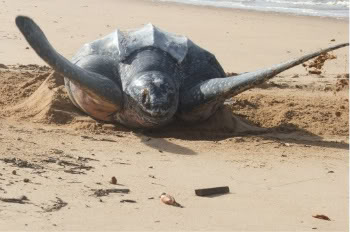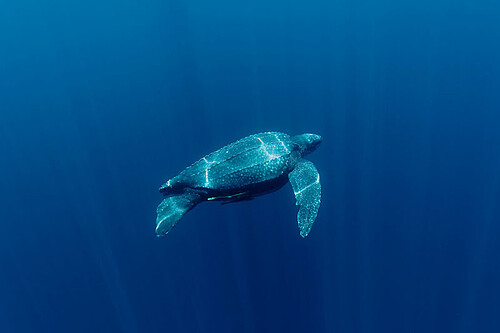Suriname is known for its stunning natural beauty and diverse wildlife, but one creature in particular is capturing the attention of both locals and tourists alike – the Leatherback Turtle. As the largest species of sea turtle, these gentle giants have been swimming the oceans for over 100 million years. However, alarming reports suggest that their numbers are dwindling, placing them on the brink of extinction. In this article, we’ll take a closer look at the Leatherback Turtle in Suriname, exploring the factors contributing to their endangerment and the importance of conservation efforts to preserve these magnificent creatures for future generations.
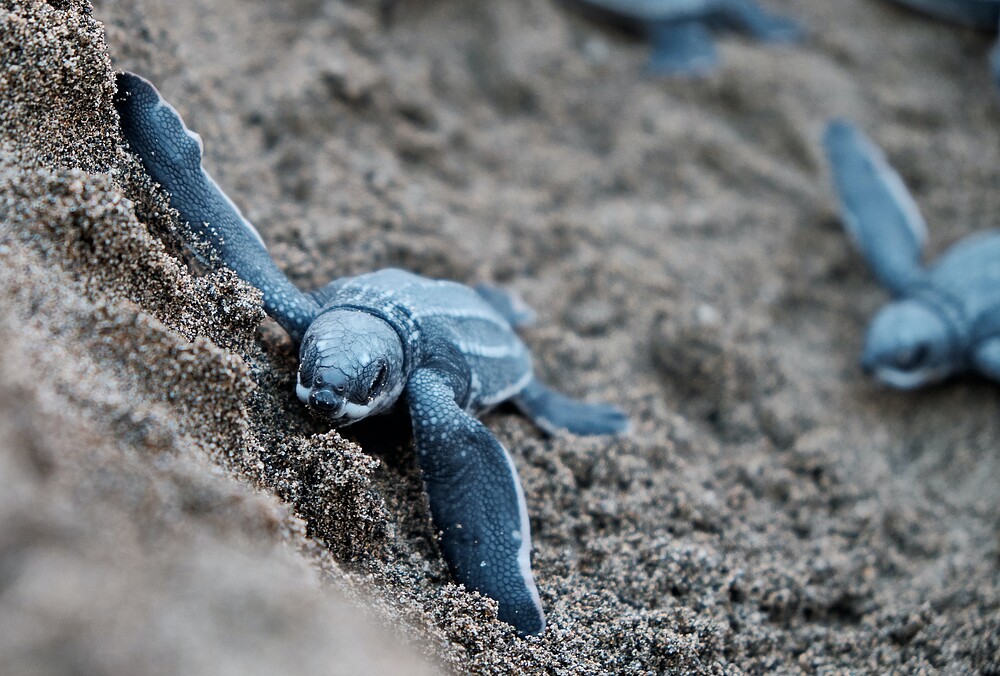
Overview of the Leatherback Turtle in Suriname
The Leatherback Turtle (Dermochelys coriacea) is an endangered species found in Suriname, a country located on the northeast coast of South America. With its unique characteristics including a leathery shell, lack of a hard bony shell, and a large size, this species has captured the attention and wonder of people worldwide.
Population decline
Over the past few decades, the Leatherback Turtle population in Suriname has experienced a significant decline. This decline is mainly attributed to anthropogenic activities such as poaching, egg collection, and habitat destruction. The nesting population, once abundant along the Surinamese coastline, has been drastically reduced, threatening the survival of the species.
Conservation status
In Suriname, the Leatherback Turtle is classified as critically endangered by the International Union for Conservation of Nature (IUCN). This classification underscores the urgent need for conservation efforts to protect and preserve the remaining population. Suriname has recognized the importance of saving this species and has implemented various measures to prevent its extinction.
Habitat and migration
Suriname’s pristine and diverse coastal areas serve as crucial habitat for the Leatherback Turtles. These turtles rely on the sandy beaches for their nesting activities. Suriname boasts vast stretches of untouched shoreline, providing ample nesting sites for these magnificent creatures. Additionally, Leatherback Turtles are known for their impressive long-distance migrations, traveling thousands of kilometers to reach their foraging grounds and nesting beaches.
Threats to the Leatherback Turtle
Human activities
One of the primary threats to Leatherback Turtles in Suriname is human activities. Poaching and illegal trade of their eggs and meat remain serious concerns. The demand for their meat and eggs, considered a delicacy in some cultures, drives this illegal trade. Additionally, accidental capture by fishing operations as bycatch poses a significant threat to the survival of these turtles.
Loss of nesting sites
Another significant threat to the Leatherback Turtle population is the loss of nesting sites. Coastal development, urbanization, and erosion contribute to the destruction and degradation of nesting beaches. Coastal armoring, such as seawalls and groins, disrupts the natural formation and stability of these beaches. As a result, Leatherback Turtles struggle to find suitable areas to lay their eggs.
Illegal trade
The illegal trade of Leatherback Turtle eggs and meat exacerbates the population decline. Despite protective legislation, the demand for these products continues, putting immense pressure on the already vulnerable population. Strict enforcement, along with public awareness campaigns, is crucial in combating this illegal trade.
Climate change
Climate change poses a significant threat to the Leatherback Turtles and their natural habitats. Rising global temperatures lead to the loss of nesting beaches due to sea-level rise and increased storm intensity. Additionally, changes in ocean currents and temperature affect the distribution of jellyfish, a primary food source for Leatherback Turtles. These changes can disrupt the turtles’ feeding patterns and impact their reproductive success.
Conservation Efforts in Suriname
Legal protection
Suriname has enacted legislation to protect the Leatherback Turtles and their habitats. The National Protected Areas Act designates specific nesting areas and imposes restrictions on human activities within these zones. The Surinamese government actively enforces these regulations, aiming to deter poaching and habitat destruction.
Research and monitoring
To better understand the Leatherback Turtle population and its behavior, ongoing research and monitoring efforts are conducted in Suriname. Scientists and conservationists track nesting activities, monitor the health of the population, and collect data on migration patterns. This information is crucial in developing effective conservation strategies and identifying priority areas for protection.
Community-based conservation initiatives
Suriname recognizes the importance of involving local communities in conservation efforts. Community-based initiatives aim to raise awareness about the Leatherback Turtles and promote their conservation. Engagement with local fishermen, schools, and communities near nesting beaches has proven effective in reducing poaching and fostering a sense of stewardship among the local population.
Nesting Behavior of Leatherback Turtles
Nesting sites
Leatherback Turtles are known for their unique nesting behavior. They return to the same beaches where they originally hatched to lay their eggs. The sandy beaches of Suriname provide ideal nesting sites, as they allow for easy excavation and concealment of eggs.
Reproductive cycle
The reproductive cycle of Leatherback Turtles begins with the females coming ashore to lay their eggs. They dig a deep hole in the sand, carefully deposit their eggs, and then cover the nest with sand. The female then returns to the ocean, leaving the eggs to incubate for approximately 60 days. After this period, the hatchlings emerge from the nest and make their way to the ocean.
Egg laying process
The egg-laying process of Leatherback Turtles is an awe-inspiring sight. Under the cover of darkness, these incredible creatures emerge from the ocean and make their way up the beach. With great determination, they dig a hole using their powerful flippers to create a safe environment for their precious eggs. Carefully depositing the eggs, they cover the nest, leaving it to the forces of nature.
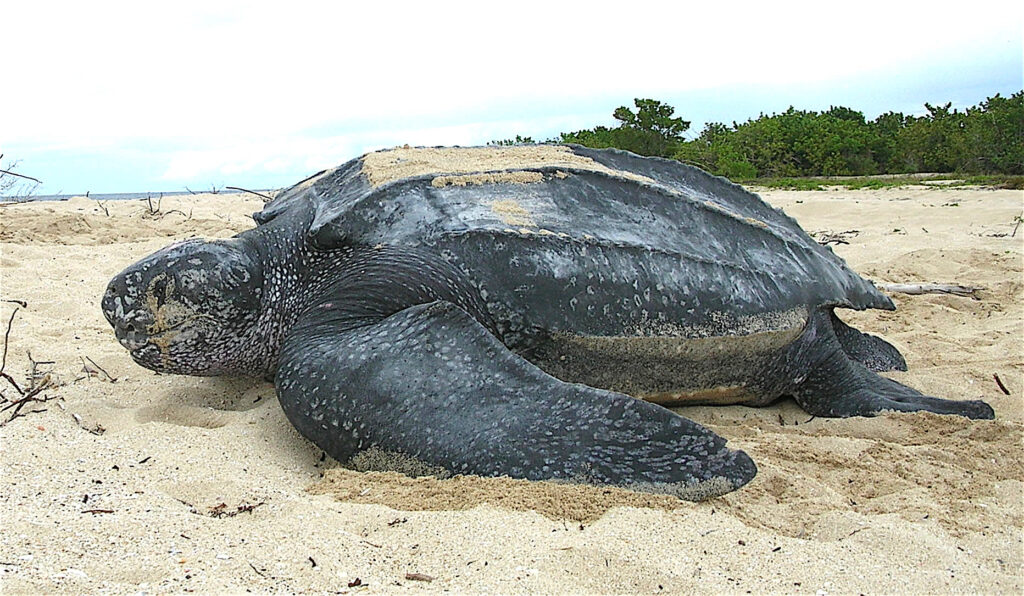
Hatchling Survival and Challenges
Predators and survivability
Hatchlings face numerous challenges as they make their way from the nest to the ocean. Predators such as birds and crabs pose a significant threat to their survival. Only a small number of hatchlings manage to reach the ocean, and even fewer survive to adulthood.
Light pollution and disorientation
Artificial lighting along the coastline poses a significant threat to the survival of Leatherback Turtle hatchlings. Bright lights can disorientate them, causing them to move away from the ocean and towards danger. Initiatives to reduce light pollution and promote the use of turtle-friendly lighting are essential in ensuring hatchling survival.
Migration Patterns of Leatherback Turtles
Long-distance migrations
Leatherback Turtles are renowned for their epic long-distance migrations. After nesting, they embark on journeys spanning thousands of kilometers to their foraging grounds. Suriname’s beaches serve as important nesting sites for Leatherback Turtles from various regions, establishing the country as a critical waypoint in their migrations.
Foraging grounds
Leatherback Turtles primarily feed on jellyfish, which are abundant in oceanic areas. They migrate to regions known for jellyfish blooms, such as the waters surrounding Suriname, to feed and replenish their energy reserves. Protecting these foraging grounds is crucial for the survival and reproductive success of these magnificent creatures.
Threats during migration
Leatherback Turtles face numerous threats during their long migrations. They are at risk of entanglement in fishing gear, collisions with vessels, and pollution from marine debris. International collaboration and strict regulations are necessary to mitigate these threats and ensure safe passage during their migrations.
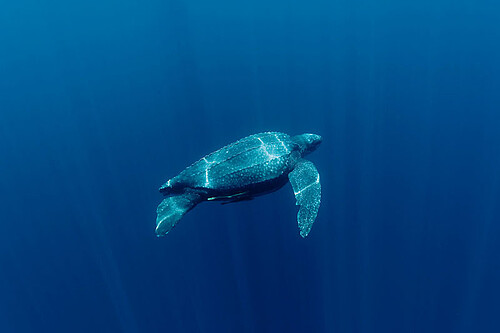
Role of Leatherback Turtles in Ecosystem
Keystone species
Leatherback Turtles play a vital role as keystone species in the marine ecosystem. Through their feeding habits, they help control jellyfish populations, preventing population explosions that could disrupt the balance of the food chain. Their presence helps maintain healthy oceanic environments and supports the overall health of marine ecosystems.
Feeding habits
As voracious consumers of jellyfish, Leatherback Turtles help to regulate their populations. This control is crucial as jellyfish can rapidly multiply and negatively impact other species. Leatherback Turtles are uniquely adapted to consume jellyfish due to their specialized feeding structures, such as spines in their throats that aid in capturing and ingesting these gelatinous creatures.
Impact on marine ecosystems
The presence of Leatherback Turtles in Suriname’s waters has far-reaching effects on marine ecosystems. By predating on jellyfish, they prevent overpopulation, allowing other species to thrive. These turtles also transport nutrients to different areas through their migrations, contributing to the overall health and productivity of the ocean.
Impacts on Suriname’s Economy and Tourism
Tourism industry
The Leatherback Turtle population in Suriname attracts nature enthusiasts and researchers from around the world. The opportunity to witness these magnificent creatures nesting and hatching has boosted the tourism industry in coastal areas. Tourists visit Suriname with the hope of experiencing the awe-inspiring sight of Leatherback Turtles and contribute to the local economy.
Ecotourism initiatives
Suriname has recognized the potential of ecotourism in promoting the conservation of Leatherback Turtles. Several eco-lodges and tour operators have implemented responsible and sustainable practices to offer visitors a chance to observe the nesting process while minimizing disturbance to the turtles and their habitats. These ecotourism initiatives provide economic incentives for local communities to actively participate in turtle conservation.
Socio-economic benefits
The conservation efforts focused on Leatherback Turtles in Suriname have not only benefited the environment but also had socio-economic impacts. Local communities near nesting sites have seen an increase in income and employment opportunities through ecotourism. This has improved the standard of living and fostered a sense of environmental stewardship within these communities.
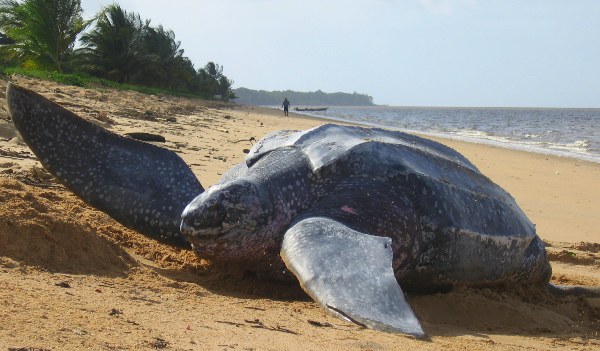
Challenges in Conservation and Sustainable Development
Lack of awareness
One of the significant challenges in Leatherback Turtle conservation is the lack of awareness among the general public. Many people are unaware of the plight facing these turtles and the importance of their conservation. Raising awareness through educational campaigns and community outreach is crucial in garnering support and promoting positive actions.
Balancing conservation and development
Finding a balance between conservation efforts and sustainable development is a challenging task. Suriname, like many other countries, faces the dilemma of economic growth and the protection of its natural resources. Ensuring that development initiatives are carried out in an environmentally responsible manner is crucial to safeguard the habitats of Leatherback Turtles and other vulnerable species.
Enforcement and regulation
Enforcement and regulation of protective legislation pose significant challenges in Leatherback Turtle conservation. Adequate resources and manpower are required to effectively monitor and enforce regulations. Collaborative efforts between government agencies, non-governmental organizations, and local communities are essential in addressing these challenges and ensuring the long-term survival of the Leatherback Turtle.
International Collaboration and Research
Global efforts
Leatherback Turtle conservation is not limited to Suriname alone. Global collaboration and efforts are crucial in ensuring the survival of this species. Organizations such as the International Sea Turtle Society and the Convention on Migratory Species work towards conserving Leatherback Turtles on a global scale. These alliances facilitate the sharing of information, best practices, and funding to support conservation efforts.
Scientific studies
Scientific research plays a fundamental role in understanding the biology, behavior, and threats faced by Leatherback Turtles. Researchers from around the world collaborate to conduct studies on nesting behavior, migration patterns, and population dynamics. These studies provide critical insights that guide conservation strategies and contribute to the global knowledge base.
Partnerships and collaborations
Conservation of Leatherback Turtles requires partnerships and collaborations between various stakeholders. Government agencies, non-governmental organizations, scientists, policy-makers, and local communities must work together to ensure the survival of this species. These partnerships facilitate the sharing of resources, expertise, and coordination of efforts to maximize the effectiveness of conservation initiatives.
